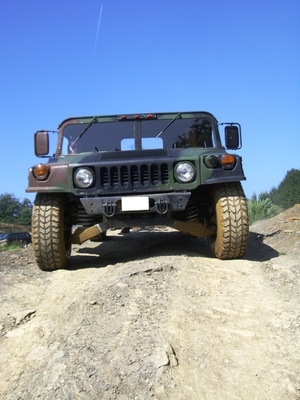
Axles come in two basic types: "live" and "dead." A live axle is so-called because it contains a gearing unit that translates the engine power delivery from longitudinal (bumper-to-bumper orientation) to lateral (side-to-side orientation) so that the tires can utilize the power. A dead axle does nothing more than link the left and right wheels, and contains no power-delivery unit. Axles can be subdivided into either straight, drop, raised and independent categories.
Straight dead axles are fairly uncommon for modern vehicles, and are usually either tubular, as in some 1970s Dodge vans, or I-beam in construction. A tubular axle is just a tube with swiveling joints on either end that allow the wheels to turn. An I-beam axle, used on many heavy trucks, has swivels as well, but uses a capital "I" shaped cross-section for light weight, fairly compact dimensions and flexibility without permanent deformation.
Many modern vehicles using a dead front axle utilize a drop-beam configuration. A drop axle utilizes a pair of curved right-angle sections just inboard of the steering joints, which results in a lower axle center section. Aside from dropping the vehicle lower to the ground, this configuration gets the spring mounts closer to or even below the wheel center-line, which yields more stable and predictable handling.
This type is by far the most commonly used for four-wheel-drive trucks. Construction is similar to the dead axle, but a live axle uses a gear, clutch or viscous fluid-driven differential in the center to deliver power to the wheels. The wheels are connect to the differential with axle shafts hidden within the hollow, weight-bearing axle tubes. The axle shafts will utilize some type of constant velocity joint-- as known as a CV joint--in the steering joint area for flexibility.
These axles are fairly uncommon, and are used only for specialty vehicles such as the original Army-spec Hummer H1 or HMMWV, Mercedes Unimog and Volvo C303. Also called "portal axles," these specialized units have a gear assembly on the outer ends to raise the axle center tube above the wheel center line. These axles have a number of advantages over normal straight, live axles: the higher axle tube gives more ground clearance, the gearing unit in the axle tips allow for a smaller diameter center differential (granting even more clearance), and the hub gearing units effectively give the vehicle more torque right at the wheel itself. This means that the vehicle can use a lighter weight transfer case, transmission and drive shafts without fear of breakage.
An independent front suspension/axle (IFS) utilizes a chassis-mounted center differential and a pair of CV joint on either ends of the axle shafts. This arrangement is similar to that used in front-wheel-drive cars, and helps to both reduce "unsprung" weight and eliminate the possibility of wheel movement on one side affecting traction on the other. Unsprung weight is dead weight sitting on the vehicle's tires, and hurts traction and ride quality in most situations.